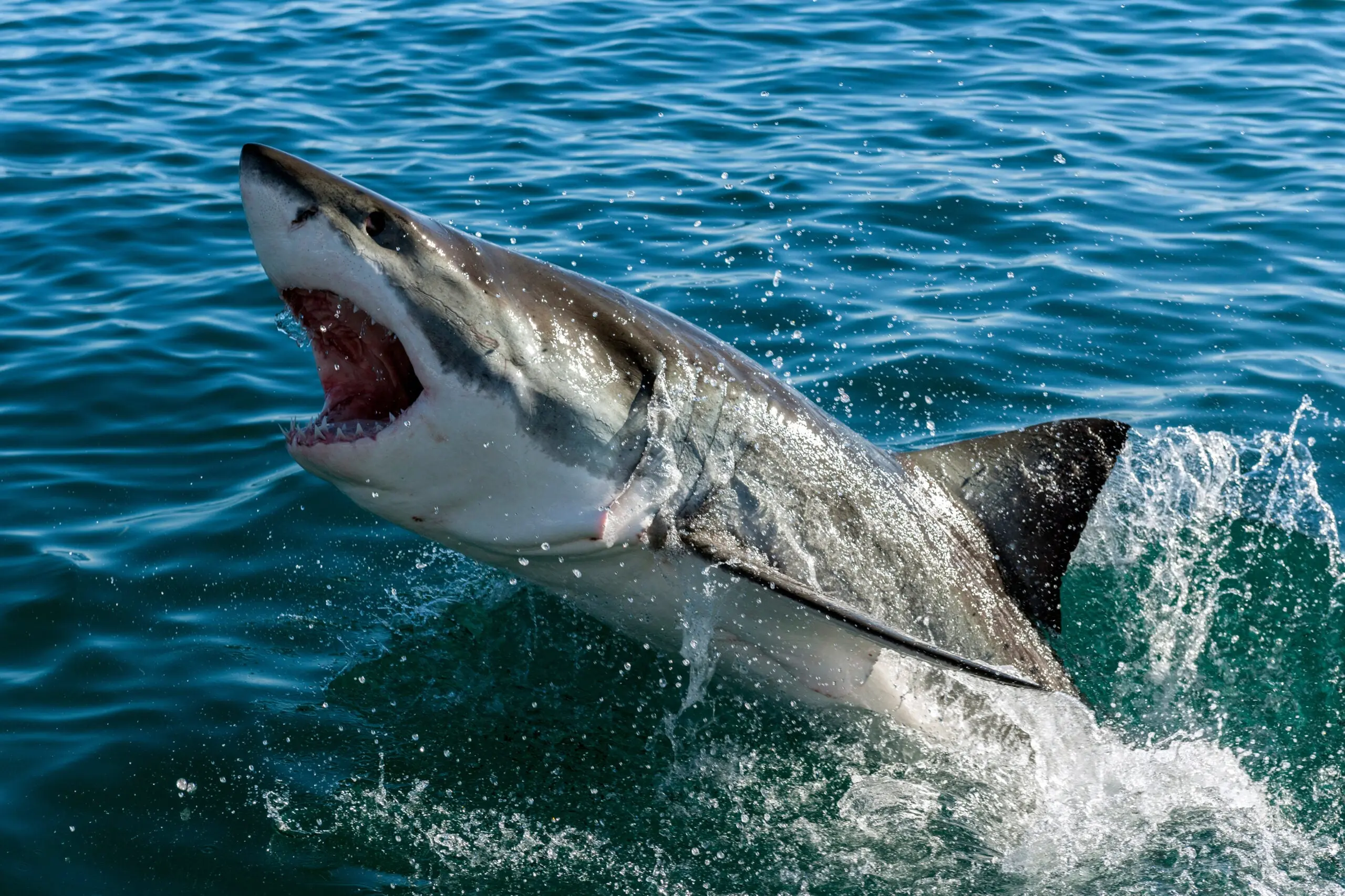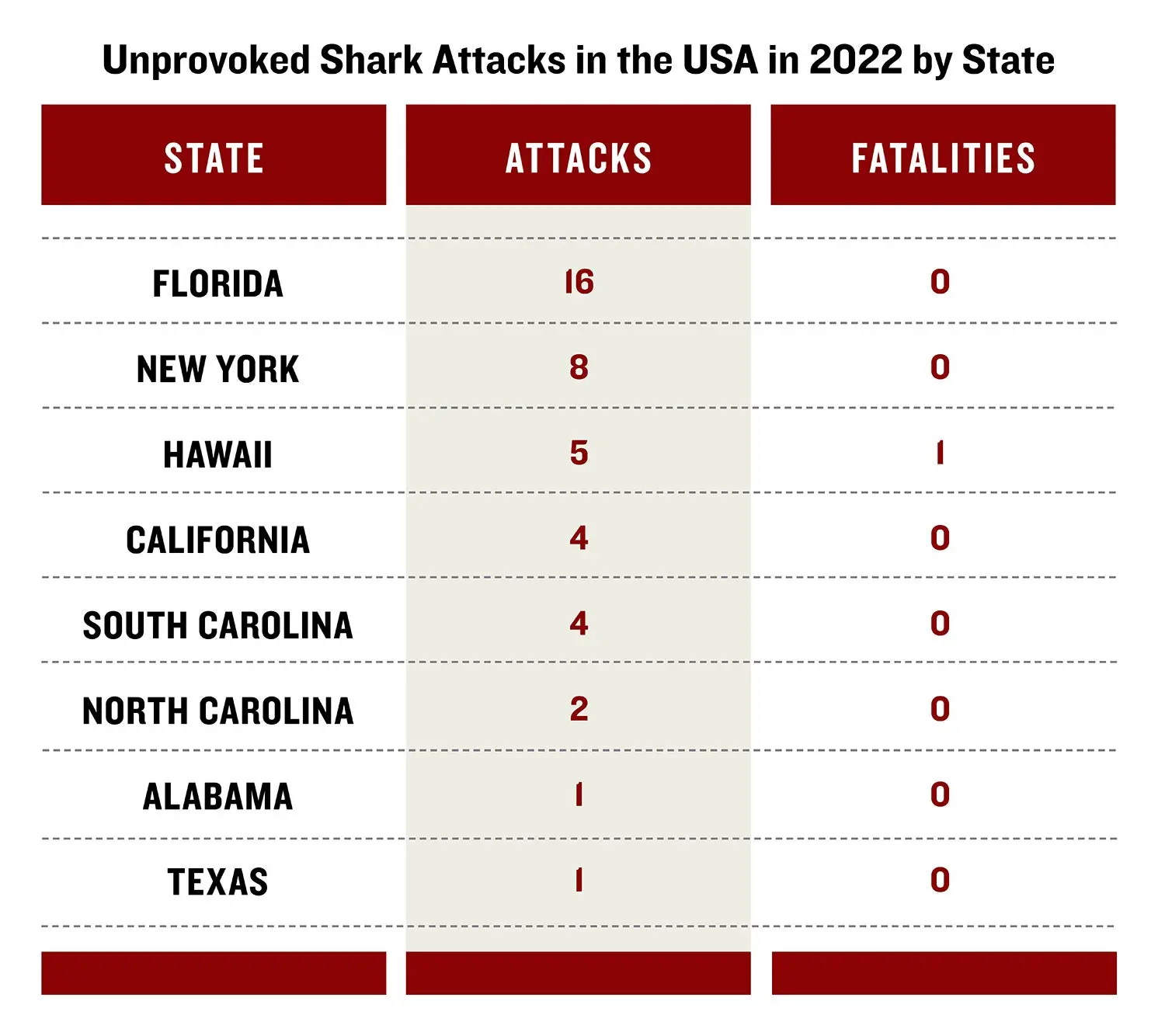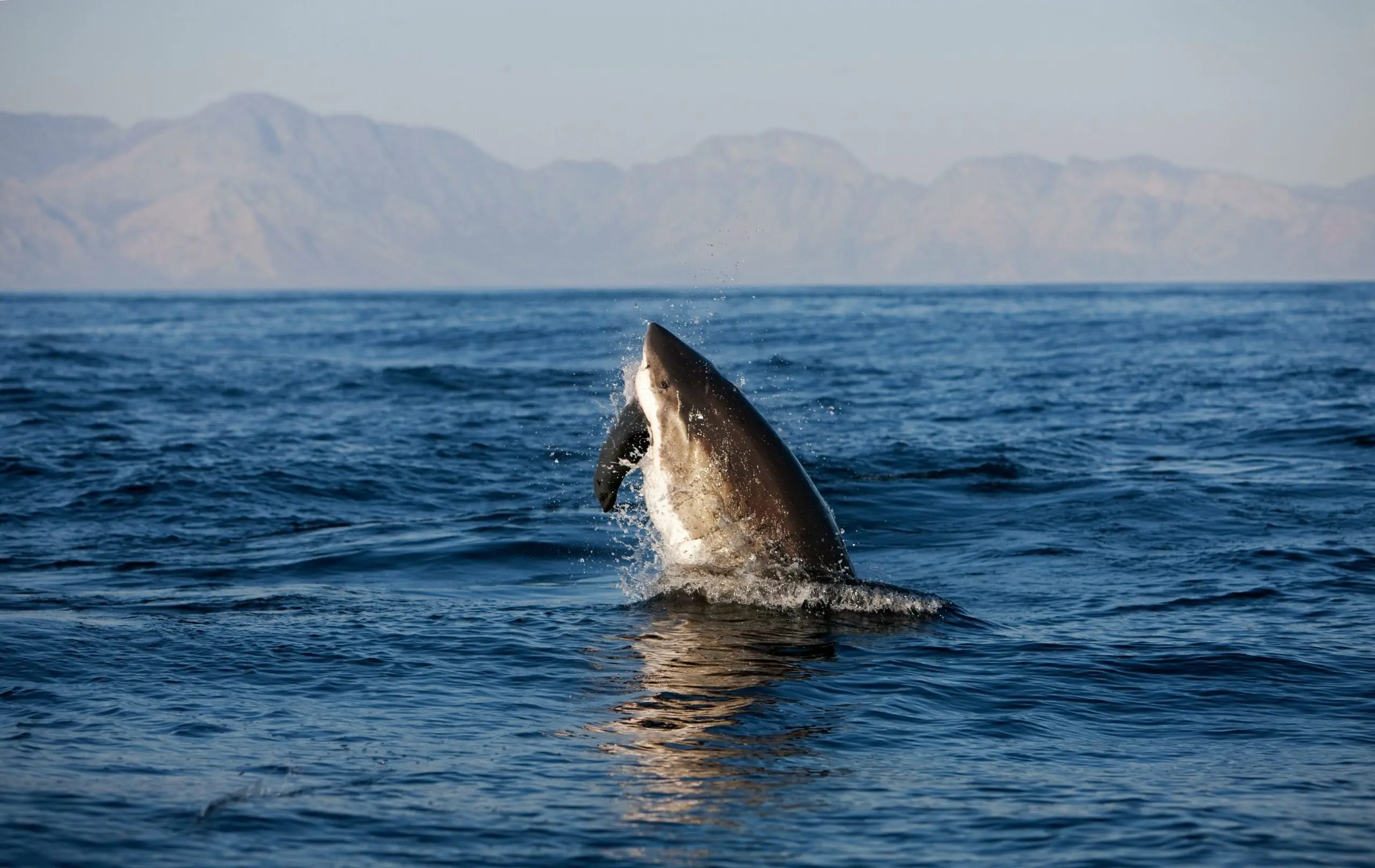Admit it. You think about it every time you step foot in an ocean. Too many viewings of Jaws or Sharknado
, maybe. Or it could simply be in our DNA. Whatever the reason, the anxiety persists: Is a shark going to attack me? Well, the answer to another question—How many shark attacks are there per year?—should ease your worries some.
The truth is, when you step into the water, you are about 3,000 times more likely to drown than you are to be killed by a shark—and about 7 times more likely to be hit by lightning than be bitten at all. In recent years, there’s been an average of 70 unprovoked shark attacks annually, leading to between five and six deaths per year. In 2022, there were 57 such attacks—a 10-year low. So, while the risk is certainly there, it’s relatively small. Here’s a breakdown of how many shark attacks per year take place, based on the latest information.
Table of Contents
How Many Shark Attacks Are There Per Year?
Where Do These Incidents Happen?
Which U.S. States Have the Most Attacks?
When Do Shark Attacks Happen?
Why Do They Happen?
Which Sharks Are Most Dangerous to Humans?
The Comparative Risk of Being Attacked by a Shark
How to Avoid an Encounter
What to Do If You Are Attacked
How Many Shark Attacks Are There Per Year?

We often think of sharks as aggressive toward humans, but the odds of being bitten are actually very low. elsahoffmann / Adobe Stock
The online bible for information on global annual shark attacks is the International Shark Attack File
(ISAF), published by the Florida Museum of Natural History. It started by tracking shark attacks on U.S. servicemen during World War II and has since developed a global tracking system and includes data going back to the 1500s. Here are the key numbers from their 2022 report:
57: Total number of confirmed unprovoked bites globally in 2022 (tied for a ten-year low)
32: Provoked bites, which “occur when a human initiates interaction with a shark”
22: Percentage decrease in unprovoked bites compared to 2021
, when 73 took place
70: The average number of unprovoked shark bites globally per year over the past five years
9: Shark-related fatalities in 2022
5: Shark-related fatalities considered unprovoked in 2022
5.6: The annual global average of unprovoked shark attack fatalities since 2000
Where Do These Incidents Happen?
According to the ISAF, the USA led the world in shark attacks in 2022, as it has for many years, by a wide margin. Shark attacks occurred in the waters of just seven of the world’s 195 countries. The U.S. had a total of 41, compared to runner-up Australia’s nine. The ISAF’s full accounting for the world’s 57 unprovoked shark bites in 2022 by country breaks down like this:

The U.S. has the most shark attacks per year by a wide margin. Source: International Shark Attack File Field & Stream
Which U.S. States Top the List?
Florida, which has led the world in shark attacks for decades, topped the list of U.S. states again
in 2022, representing 39 percent of this country’s unprovoked attacks and 28 percent worldwide. However, none of those Sunshine State attacks were fatal. Hawaii had the only U.S. unprovoked shark-attack fatality in 2022. (Would you have ever guessed that New York would be second on this list?) Here’s the full state breakdown:

Florida and New York had more attacks in 2022 than all other states combined. Source: ISAF Field & Stream
When Are Humans Most Vulnerable?

Researchers believe that when sharks attack humans it’s often because they have mistaken them for natural prey. slowmotiongli / Adobe Stock
that since the 1980s people surfing or enjoying other board sports have been far and away most likely to be attacked. However, that trend shifted in 2022 when 43 percent of the year’s unprovoked shark attacks occurred while victims were swimming or wading, whereas 35 percent took place while victims were surfing or boarding. Nine percent of victims were snorkeling
or free-diving, while the remainder were jumping in the water, climbing out of the water, floating on a raft, scuba diving, or doing some other water activity.
Why Do These Incidents Happen?
While the world’s 500-plus shark species eat a strikingly wide range of seafood, humans are not on their natural menu. On the rare occasions when attacks do occur, according to American Oceans,
the reason is confusion, curiosity, or a case of mistaken identity. Scientists believe sharks may mistake surfers, paddleboarders, or swimmers for seals or sea lions, especially in murky waters. Curiosity may lead to a “bite test,” after which the victim is released when it is recognized as the wrong target.
Which Species Are Most Dangerous?

Great white sharks account for the most attacks, by far. wildestanimal / Adobe Stock
The ISAF offers data showing which shark species are implicated in reported attacks; however, they caution that these figures may be misleading, as it is often difficult for the victim and investigators to determine the species. Of 949 recorded bites in which a specific species of shark was implicated over the past two decades, 34 different shark species have been implicated. Here are the top ten:

White, tiger, and bull sharks were implicated in the large majority of attacks. Source: ISAF Field & Stream
The Comparative Risk of Being Attacked by a Shark
On average, 270 people in the U.S. are struck by lightning each year, of which 27 die. In 2021, 26,031 people were murdered in the country, all of which died. Compare those figures
to the 41 people in the U.S. who were bitten by sharks in 2022, and the one who died. You are nearly seven times more likely to be struck by lightning—and 635 times more likely to be murdered—than you are to get bit by a shark. And your odds of surviving the shark bite are 47 times better than surviving the lightning bolt. Your chances of surviving a murder are, well, you know.
How to Avoid an Encounter
If you would like to decrease your already-low odds of being attacked by a shark, here are some key tips from the the Florida Fish and Wildlife Conservation Commission
:
Stay in groups close to shore; sharks are more likely to attack isolated individuals
Avoid ocean waters during darkness or twilight hours when sharks are most active
Do not wear shiny jewelry or contrasting colors; they resemble fish scales/patterns
Refrain from splashing; it could attract sharks
Don’t swim in murky waters; sharks my think you are their natural prey
Never harass a shark!
What To Do If You Are Attacked
Also, from the FFWCC:
Don’t make a sudden dash or other movements
Keep eye contact with the shark to show them you mean business
If the shark attacks, go wild (punch, kick, use your surfboard or anything you can access)
If it doesn’t bite, back away slowly and get out of the water






